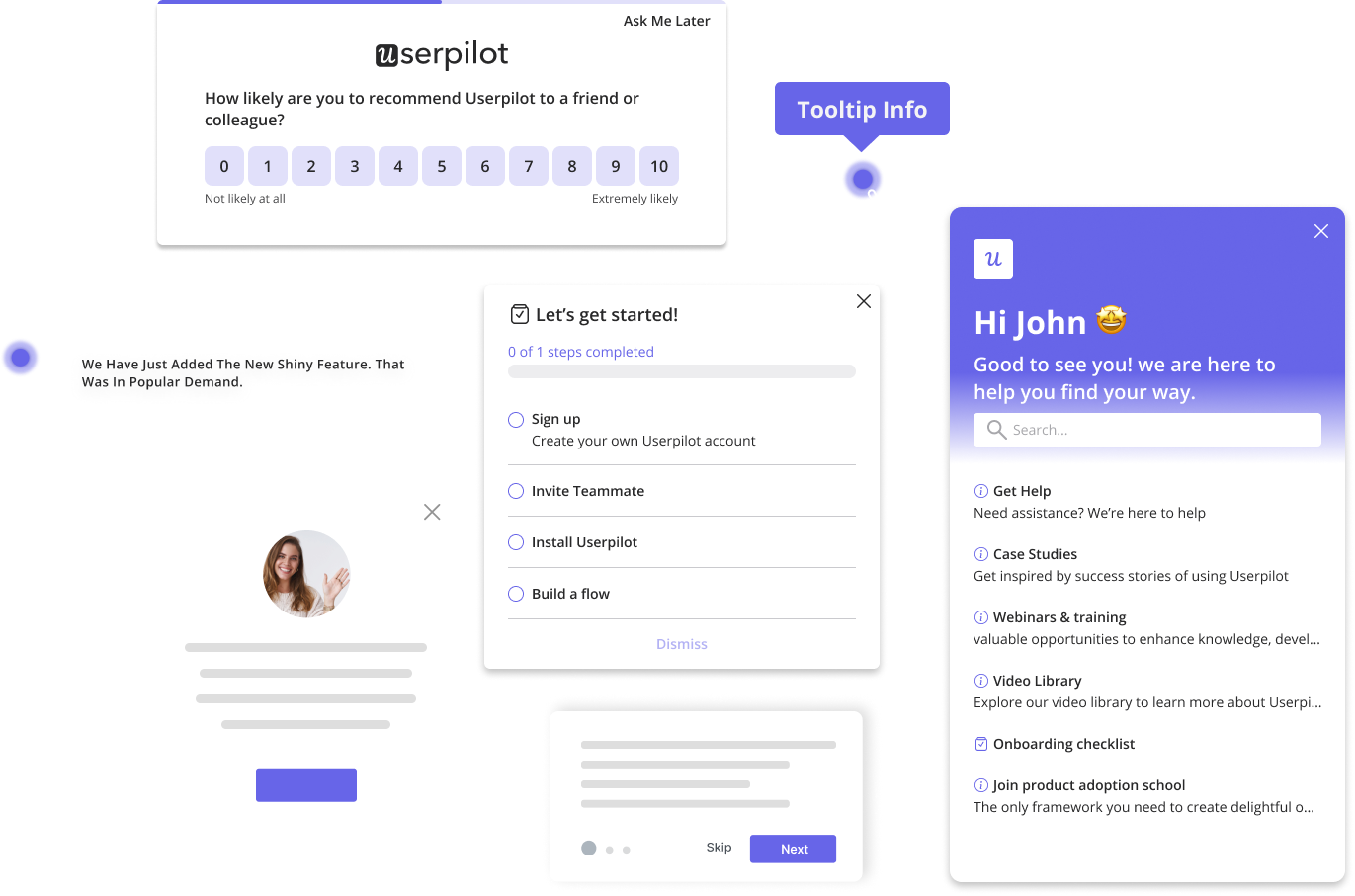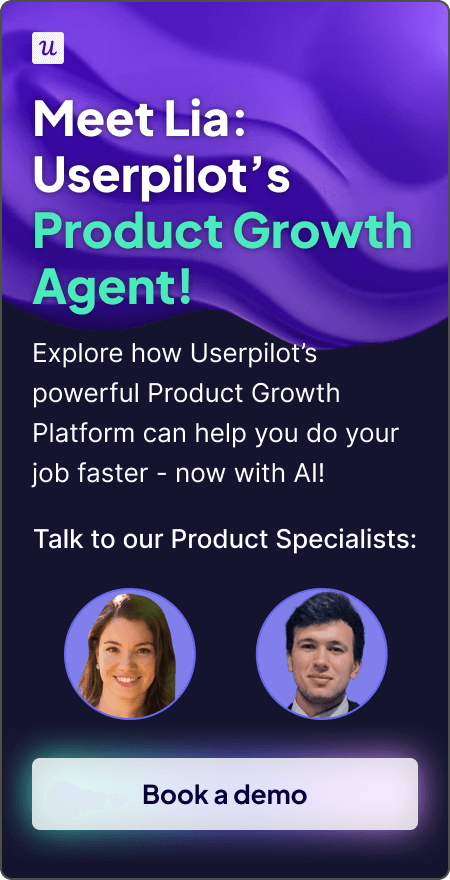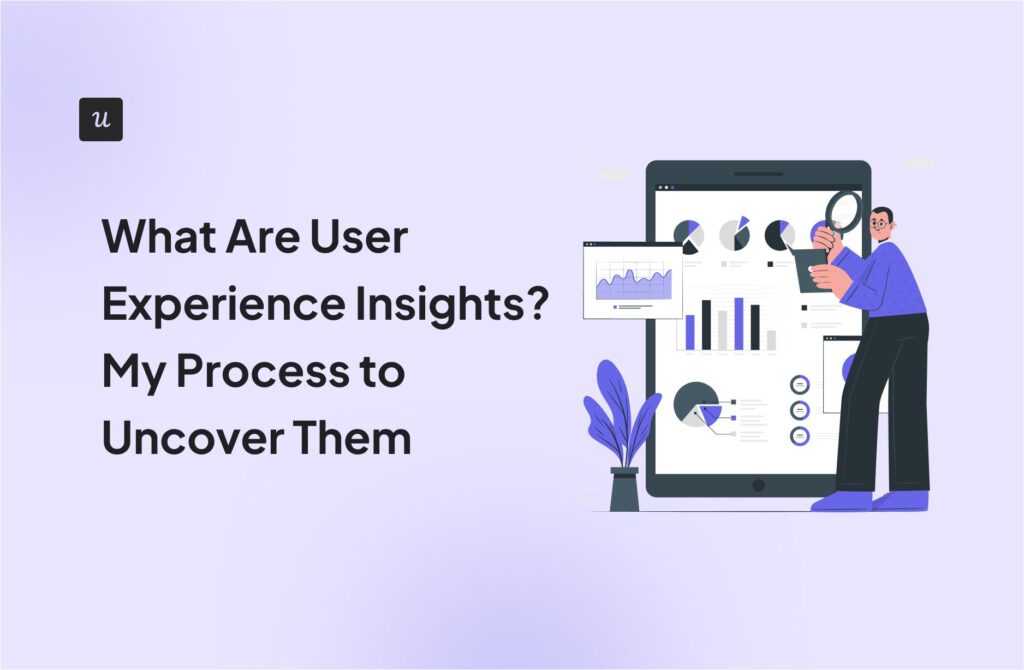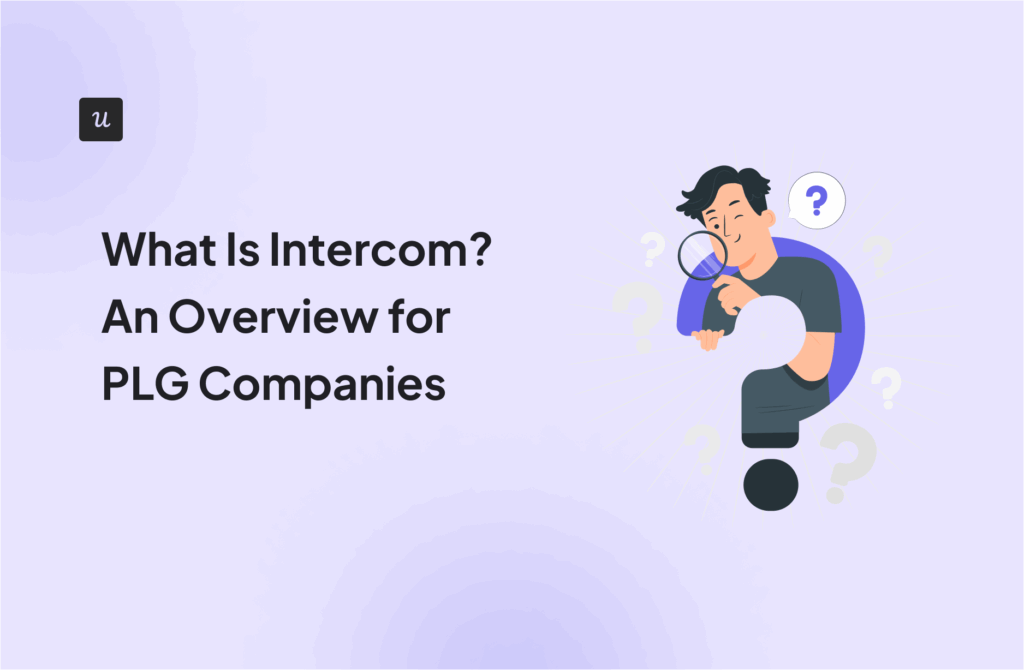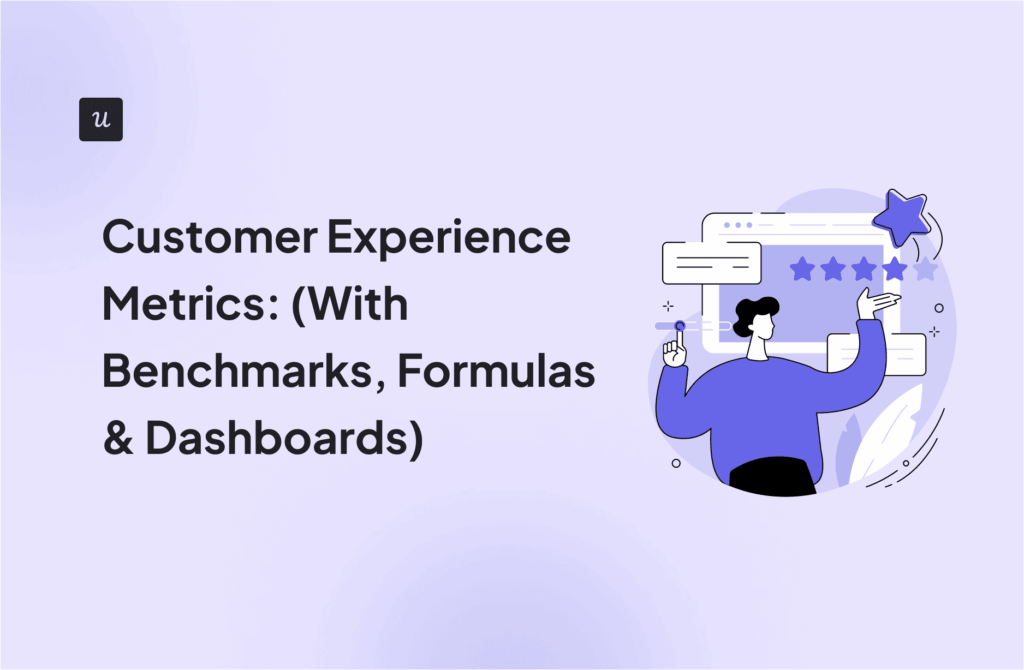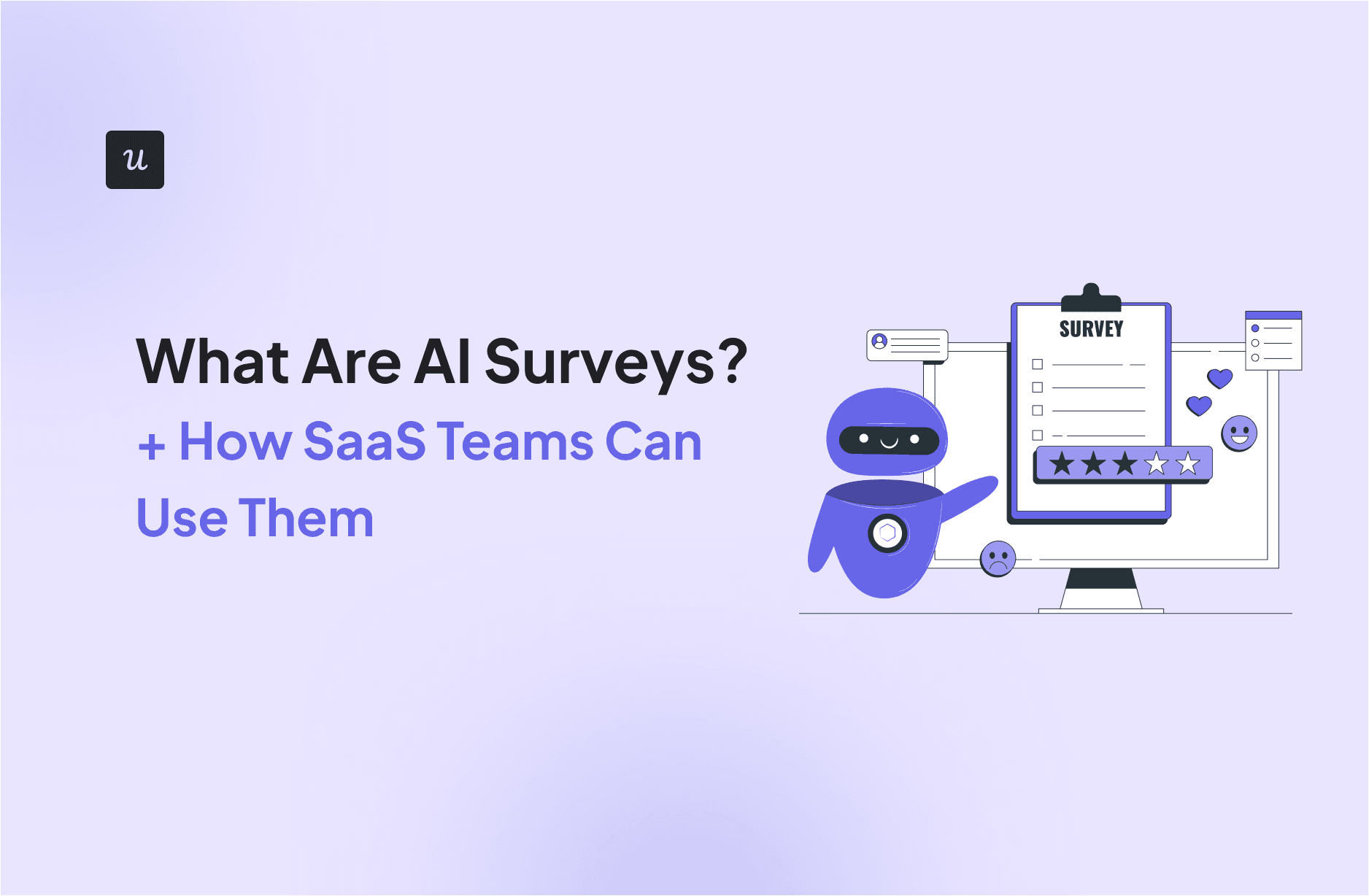
According to Maze’s 2025 report, respondents cite time and bandwidth as their biggest challenges in user research. AI surveys are starting to ease this pain by making customer feedback faster to collect and easier to act on.
I’ve experienced the benefits firsthand and want to share what I’ve learned. In this article, I’ll walk you through what AI surveys are, the benefits they bring, how they work, and the ways SaaS teams can use them to drive growth. I’ll also share some practical dos and don’ts to help you avoid common pitfalls.
Try Userpilot Now
See Why 1,000+ Teams Choose Userpilot
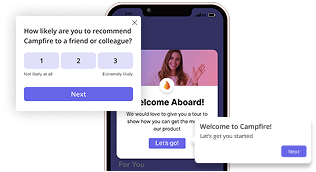
What are AI surveys?
An AI survey is any survey powered by artificial intelligence capabilities such as natural language processing and machine learning.
Instead of relying on static forms, these surveys can generate smarter, context-aware questions, trigger real-time follow-up prompts, and automatically analyze responses at scale.
What are the benefits of deploying AI surveys?
In the short time I’ve experimented with AI surveys, I’ve realized they provide the following benefits:
- Faster customer feedback loops: Traditional survey creation and survey delivery often take days or weeks, followed by even more time spent on manual data analysis. AI surveys compress that entire process into minutes by automating setup, clustering responses, and surfacing accurate insights in real time.
- Scale: AI tools make it possible to process thousands of comments or survey responses without drowning in spreadsheets. Whether you’re running a small NPS survey or conducting large-scale surveys across your customer base, analysis remains just as quick.
- Smarter follow-ups: This is the part I love the most. With traditional survey flows, you have to hard-code every possible path. If a user says X, you show Y. AI surveys remove that burden. They can interpret open-ended responses and generate tailored follow-up questions you didn’t have to pre-script.
For example, if someone writes “I struggled with setup,” the AI might ask: “Was it integrations, permissions, or configuration that slowed you down most?” This sort of dynamic probing saves time and helps you generate deep insights without designing dozens of branching flows.
How do AI surveys work?
AI surveys typically follow a three-step process: data collection, analysis, and action.
- Data collection: This is where you create surveys. You can feed the AI with a specific instruction, like “Ask new users what they love about our onboarding flow,” and it will generate clear, unbiased questions that get to the heart of the issue.
- Analysis: Once responses start coming in, the AI will automatically cluster feedback into themes and identify patterns that help you quickly make sense of survey data. For example, if it’s an NPS survey, the tool might show that detractors are unhappy with onboarding, pricing, and usability, while promoters highlight great customer support and product reliability.
- Action: This final stage is where the AI survey tool helps you prioritize feedback by severity and impact. Back to our NPS example: after surfacing the core reasons for dissatisfaction, the AI might reveal that the most recurring issue is that your onboarding flows are confusing. With that insight, you immediately know where to focus your efforts for maximum impact.
Where can AI surveys drive SaaS growth? 4 Key use cases
From onboarding to adoption and churn, AI surveys help you collect valuable insights at every stage of the customer journey. Let’s discuss four use cases:
1. Onboarding feedback: Spot drop-off early
Onboarding is often the moment of truth for a SaaS product. If new users can’t get up and running quickly, they’re far more likely to abandon the product before they ever see its value. Traditional surveys usually miss this window because they’re either sent too late or designed with vague questions that don’t capture real blockers.
AI surveys solve this by letting you gather immediate, contextual feedback during those first crucial interactions. Instead of waiting until onboarding is complete before asking a generic “How was your onboarding?”, you can check in after Day 1 and adapt questions on subsequent days based on user behavior.
This makes feedback timely and actionable, so you spot friction early and prioritize fixes before drop-offs pile up.
2. Feature adoption: Find out what’s sticking
We analyzed almost 200 SaaS companies and found that the average core feature adoption rate is just 24.5%. If customers aren’t adopting your core features, it means they’re not maximizing your tool or realizing its intended value, which risks both retention and expansion.
AI surveys can help you understand why users love certain features, why they don’t engage with others, and how you can improve. For example, after releasing a new reporting dashboard, you could survey users who tried it at least once.
The AI might reveal that some users praise the speed and clarity of the reports, and dissatisfied customers complain about missing filters or confusing navigation. This gives you a clear picture of what is sticking and improvements to prioritize in your product roadmap.
3. Churn prevention: Learn why users leave
UserMotion’s 2024 report shows over 80% of B2B SaaS churn is voluntary. The majority of these customers exit quietly without giving clear reasons, which makes it difficult to know what went wrong.
AI surveys give you a structured way to capture and understand those reasons. By triggering short exit surveys when a user cancels or downgrades, the AI can cluster responses into themes such as pricing objections, integration gaps, or slow onboarding. More importantly, it highlights which issues recur most often, so you know what is actually driving churn.
4. NPS and CSAT: Go beyond the score
Sentiment analysis powered by modern AI models goes beyond simple positive or negative ratings and detects the emotional nuances in feedback. Traditionally, you might categorize users who rate you 5 and 6 as being in the same group, but in reality, one may be mildly irritated while the other is furious. AI models help you uncover that difference.
Another advantage is real-time analytics. NPS and CSAT scores are historical by nature. By the time you collect responses, analyze them, and prepare a report, customer sentiment may have already shifted, and some users may already be gone. With AI-powered tools, you can build flows where an AI agent flags a negative or emotionally charged response and instantly alerts a customer success manager to reach out.
From surveys to self-optimizing growth: The Product Growth Agent
Userpilot is building a comprehensive AI assistant designed to help you do much more than gather customer feedback.
Once launched, it will be able to:
- Detect drop-offs during onboarding: When the agent notices users stalling at a particular step, it can suggest or even build new onboarding flows to remove friction. Instead of waiting weeks to discover where customers struggled, you will have an always-on partner that spots the problem in real time and offers solutions instantly.
- Monitor feature adoption: The Product Growth Agent will continuously track how users engage with your features. If it detects that adoption is lower than expected, it can proactively launch nudges such as tooltips, modals, or checklists to guide users toward success.
- Analyze survey data: The Product Growth Agent can surface pain points and translate them into clear, actionable recommendations. You will also be able to dig into individual responses to see how users describe their experience in their own words. This combination of high-level themes and granular detail will help you understand both the patterns and the nuance, so your team knows what to fix and why it matters to customers.
How will the Product Growth Agent work?
Our Product Growth Agent will function in three modes:
- Observe: In this mode, the agent will quietly watch how users move through the product. It will collect data, identify trends, and flag opportunities without making changes on its own.
- Copilot: Here, the agent will shift from observation to active assistance. It will suggest improvements, recommend nudges, and can even help you execute flows directly. You still stay in the driver’s seat, but with an intelligent partner that makes your decisions faster and more informed.
- Autonomous: If you want, the Growth Agent can take ownership of specific parts of the journey and optimize them automatically. For example, it can launch tooltips, adjust onboarding flows, or trigger experiments without waiting for manual input.
It’s also worth noting that the agent can run multi-strategy playbooks in parallel. For example, it can monitor onboarding drop-offs, boost adoption for a new feature, and manage product-led growth campaigns all at once.
This means you no longer have to juggle multiple tools and dashboards just to keep your PLG operations running. Instead, you get a single AI partner working 24/7 to keep growth loops firing continuously.
The dos and don’ts of AI surveys for customer insights
AI surveys speed up feedback collection, but speed without vigilance can lead to skewed insights that harm data quality and prevent you from making sound, data-driven decisions.
I’ve compiled a few dos and don’ts to help you avoid these pitfalls. Let’s go over them.
1. Spot and stop the AI echo chamber
Don’t: Assume long, polished answers are always valuable.
Risk: A Stanford Graduate School of Business working paper shows that about 34% of survey respondents already use large language models like ChatGPT and Gemini to answer open-ended survey questions.
These AI-generated responses often come across as overly positive, repetitive, and stripped of the subtle cues that reveal human emotion, such as hesitation, frustration, or blunt criticism. If too many of these polished answers dominate your dataset, you risk basing decisions on artificial responses rather than genuine customer pain points.
Do: Watch for uniformity in tone or suspiciously positive language
Action: Flag feedback that feels too good to be true, and validate with a human read.
For example, it’s worth double-checking if multiple respondents describe onboarding as “seamless and delightful” using nearly identical wording.
Real users tend to give varied, specific answers, like “setup was quick but integrations were confusing” or “I liked the walkthrough but got lost on permissions.” Spotting this difference helps you separate authentic insights from AI-influenced noise.
2. Write questions that block filler
Don’t: Ask vague prompts like “What do you think of onboarding?”
Risk: If you rely on vague questions, you end up with responses like “Onboarding was fine” or “It was smooth,” which provide no real guidance. Worse, when these kinds of empty statements pile up, they can mask genuine friction points and lead your team to believe something is working better than it really is.
Do: Ask specific, clear, and unbiased questions
Action: Frame your survey questions as precisely as possible so the responses are useful and actionable. If you are using an AI survey tool to generate the questions, make your prompts detailed and specific. The clearer you are with your instructions, the better the AI will perform when drafting questions that avoid vagueness.
For example, instead of the generic “What do you think of onboarding?”, ask “What slowed you down most while setting up your first project?” This guides users to share concrete obstacles rather than filler responses.
3. Pair words with hard data
Don’t: Take open-ended responses at face value.
Risk: Users often downplay or misrepresent their experience, either intentionally or without realizing it. Someone might write “the feature is good,” yet your analytics tell another story with rage clicks, repeated errors, or sharp drop-offs at a key step.
Do: Cross-check feedback with behavioral data
Action: Blend survey results with product usage or session replays.
Userpilot helps you do this easily. You can track product usage data by segment to see if survey feedback matches actual in-app behavior. And if you need visuals, our session replay tool lets you watch exactly how users interacted with specific features, so you can pinpoint friction with confidence.
4. Keep humans in the loop
Don’t: Treat AI insights as gospel
Risk: AI clusters and summaries are helpful for spotting themes, but they’re not flawless. Without human oversight, the AI can group subtle differences in wording together incorrectly and may overlook low-frequency but high-impact issues.
Do: Review raw responses and apply judgment
Action: Always sample 5–10 comments per theme before acting.
For example, if the AI flags “pricing concerns” as a top issue, read a handful of the actual comments yourself. You might find that users are not complaining about price in general but about the lack of flexible billing options. That nuance changes the solution entirely and ensures you are fixing the right problem.
Turn raw responses into responsible action
AI surveys help speed up data collection and interpretation, but insights alone don’t create value.
Once you validate findings with human judgment, the next step is to translate them into improvements, whether that means refining your onboarding flows, deploying clearer in-app guides, or making UI changes that remove friction.
Userpilot simplifies the process. Our platform lets you act on customer insights with UI elements like tooltips, checklists, and modals. After rolling out updates, you can use our analytics to track user behavior and see whether customers are responding as expected.
Ready to see it in action? Book a demo today.
FAQ
Can you use AI in surveys?
Yes. You can use AI to:
- Generate smarter survey questions.
- Adapt follow-up questions based on previous answers.
- Cluster qualitative feedback into clear themes.
- Detect sentiment and emotional tone in answers.
- Prioritize insights by frequency and impact.
💡 Bonus: While AI surveys are widely used in SaaS, they can also unlock valuable insights from public opinion data in areas like politics, academic research, or consumer studies.
What’s the best AI survey tool?
The best AI survey tool depends on what you want to achieve. Some platforms focus only on survey creation, while others handle analysis.
With Userpilot, you will soon have an all-in-one solution that combines everything in one place. You will be able to create surveys, analyze data with AI, spot trends, and act on insights immediately through in-app messages and flows.
What are examples of AI survey questions?
AI-generated questions are usually more specific and context-aware. Instead of vague prompts like “Do you like this feature?” an AI survey might ask:
- “What did you expect to see when using the dashboard filters?”
- “Which part of the reporting process feels most time-consuming?”
- “If you could change one thing about the search function, what would it be?”
What is the best sample size for a survey?
The right sample size depends on your customer base and the level of confidence you need. For SaaS teams, aiming for at least 100 to 200 responses per segment usually provides enough data to glean meaningful user and market research insights.
Got a small sample size or dealing with low response rates? AI survey tools can still add value by highlighting sentiment shifts and pointing to recurring issues that might otherwise go unnoticed until more responses come in.

